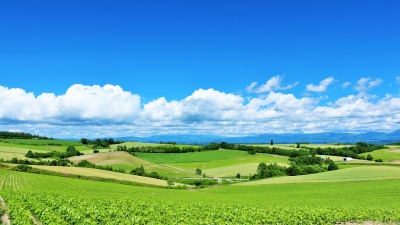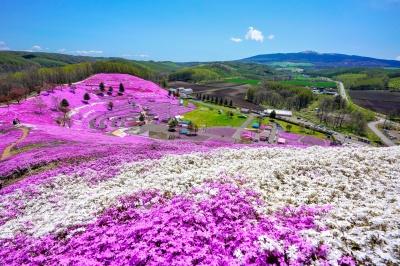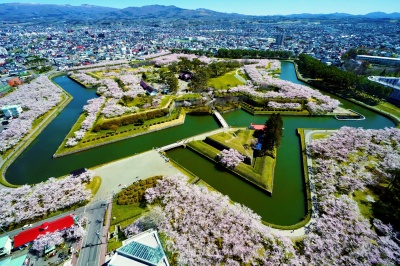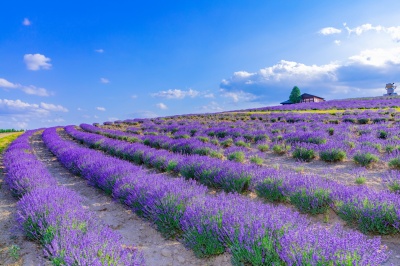Into the Wild: Experience why Shiretoko is Hokkaido’s only World Natural Heritage Site

Located on a peninsula that stretches out into the Sea of Okhotsk, Shiretoko National Park takes its name from the Ainu word “Shiretoko”, or “Land’s End”. Registered as a world natural heritage site, the oceans and forests of Shiretoko are home to a wide variety of flora and fauna. From sea kayaking and hiking to walking on drift ice; a countless number of adventures await!
Shiretoko is the only site in Hokkaido that is registered as a UNESCO World Natural Heritage Site. There is a reason for this, as the area features a variety of natural treasures including a pristine land- and seascape as well as one of the world’s richest ecosystems. This beautiful environment also changes dramatically with the seasons, from the lush forests in the summer to the snow-capped mountains in the winter. Furthermore, you do not need to fret the harsh natural environment: while it is always advisable to take common-sense precautions before venturing into nature, there are several spots that allow you to experience Shiretoko’s beauty in a casual manner. One example is the trekking tour towards Lake Rausu, a high-altitude course that is notable for featuring a large variety of alpine plants. Even if you go in June or July, you will be able to walk across remaining snow! Moving along, the Kamuiwakka Hot Falls are unique in that they are, as the name suggests, hot: the water that flows into the waterfall comes from a nearby active volcano. Be sure to go for a dip in the waterfall’s basin. Another highlight is the Sea of Okhotsk, which has a lower altitude than any other frozen sea in the northern hemisphere. You can experience this mysterious body of water for yourself by taking a walk on the frozen shoals during the “Ryuhyo Ice Walk”. Meanwhile, the fact that you can encounter many wild animals including brown bears, deer, red foxes or even dolphins when enjoying the experiences outlined above just add to the intrigue of the area. Shiretoko’s access is also quite convenient, taking less than 4 hours from Tokyo – a 1 hour 40 minutes flight from Haneda to Memanbetsu Airport followed by a 2-hour drive. In this article, we will showcase our 9 favorite spots so that you know everything you need to begin your very own Shiretoko adventure.
- * Please note that the text shown on this page includes machine translations.
Shiretoko Goko Ground Pathways
The Shiretoko Goko Lakes are surrounded by a primeval forest, with the majestic silhouette of the Shiretoko Mountain Range in the background. If you venture here, the first thing you will notice is the subtle trace of the wide variety of wild animals that call this area home, including brown bear claw tracks in the ground and black woodpecker feeding marks. You can experience the area around the lakes using the specially installed ground pathway, though be aware that there are designated periods designed to protect the ecosystem. These periods range from April 20th to May 9th and August 1st to November 8th and you will need to register in advance at the Shiretoko Goko Field House if you want to visit during these times. The registration process includes a short ten-minute lecture as well as the payment of a fee (the process changes in the period from May 10th to July 31st , when the active period of brown bears commences; see the link below for all the details). Be aware that these conditions are subject to change based on the frequency of brown bear sightings.
Lake Rausu Hiking
As we mentioned in the outset, it takes about 2 hours by car to get to Shiretoko from Memanbetsu Airport. From there, one destination to aim for is Shiretoko Pass, where you can enjoy great views of Shiretoko’s highest peak, Mount Rausu. It takes about 20 minutes to reach from Utoro Port, also known as the gateway to the Sea of Okhotsk. The easy access to numerous natural highlights is one definite plus of sightseeing around Abashiri. Now, if you want to leave the car, get active and do some trekking: we recommend the trail that continues towards Shiretoko’s largest lake, Lake Rausu. This high-altitude (equivalent to around 2,000 to 2,500 meters above sea level on Japan’s main island) course is notable for featuring a large variety of alpine plants. Even if you go in June or July, you will be able to walk across remaining snow! It is about 3 kilometers from the trailhead to the lake, though there are some tricky ups and downs to prepare for. Therefore, budget about half a day for the trek (trust us, the feeling of accomplishment upon finishing the course is worth it!). The trekking season is from June to October, with numerous tours available as well.
Kamuiwakka Hot Falls
Kamuiwakka Hot Falls – the name says it all. As the water flowing into the waterfall comes from a nearby active volcano, the waterfall’s basin doubles as a hot spring. This makes the falls the perfect spot for taking a dip to relax after the climb up the mountain stream. While you don’t need to join a designated tour for the hike, the area is not maintained regularly. Therefore, be acutely aware of your surroundings, with our recommended gear being marine shoes or rubber boots paired with shorts. Also, if you have sensitive skin and are planning on going for a bath, take note of the strong water pressure and acidity levels. You can access the falls from June to the end of October.
Shiretoko Sightseeing Ship
If you want to get a sense of the sheer scale of the Shiretoko Peninsula, we recommend the Shiretoko Sightseeing Ship Aurora. In operation from April to October, it provides you with spectacular views of the area only available from the vantage point of the ocean. The route stretches from the Oronkoiwa Rock (close to the Utoro Fishing Port) all the way up to the peninsula’s most northern point, Cape Shiretoko. En route, you will be able to enjoy numerous sea caves and waterfalls that pour into the ocean. Depending on your luck, wild animals you might encounter include brown bears, deer, red foxes, sea eagles, owls, dolphins and seals. If you are at all into photography, make sure to pack your best zoom lens to get some prime wildlife shots from the ship’s upper deck.
Sea Kayaking
The Shiretoko Peninsula, where you can row along the beautiful cliff-lined coastline, is said to be somewhat of a Mecca for kayakers. One popular tour (“Natsu Kayak”, or Summer Kayak) is offered by the “Shiretoko Outdoor Guide Center” and it brings you from Cape Puyuni to the Yunohana Waterfall, also nicknamed “Men’s Tears”. The tour lets you get up close and personal to Shiretoko’s breathtaking nature: you will row among 200-meter-tall rugged cliffs and gaze directly up into vigorously flowing waterfalls. The high-grade sea kayaks provide excellent stability, making the tour attractive for novices as well. It is in operation from the end of April to the end of October. However, be aware that if you measure over 180cm or weigh over 90kg, there is no gear fitting your needs, meaning you will sadly have to forego this tour.
Ryuhyo Ice Walk
Drift ice is a natural spectacle that most people only get to experience extremely rarely. Luckily, the Sea of Okhotsk is known to freeze completely in the winter months, and there is a tour that lets you experience the unique pleasure of literally walking on an ocean – namely the drift ice tour offered by “SHINRA”. After putting on a specialized dry suit that is equipped with boots and offers high heat retention over your regular clothes, you can begin your walk on the ice. The experience is akin to walking on frosty stepping stones. Once you have ventured out, you will be able to experience a view usually reserved to sea otters – the endless white of the drift ice. If you are lucky, you may even be able to encounter Clionidea, otherwise known as the angels of the drift ice. However, while it is easy to get immersed in the spectacular view, do remember that you are literally walking on ice. Be aware of your steps and avoid slipping!
Astronomical Observation
Using a Reflector Telescope with a diameter of 200mm and a focal length of 800mm, the “Starhourse Shiretoko Nature Experience” offers a spectacular program centered on astronomical observation. The tour lasts for about one hour and meets at Cape Puyuni, reachable if you head north on National Highway 334. Of course, the weather conditions change daily and will impact your viewing experience, but that comes with the territory. You are gazing upon the actual sky after all! The tour only requires light walking, meaning that you can make this a family affair with all ages being welcome.
Ryuhyo Monogatari Train
Another unique way to experience the region is the sightseeing train “Ryuhyo Monogatari Train”, operated by JR Hokkaido. The train commenced operations in 2017; in 2021, the train will run from Abashiri to Shiretoko Shari in the period from late January to late February. There are no reserved seats. If you take the up-train for Abashiri, it will stop for about 20 minutes at Hama-Koshimizu Station, allowing for some quick shopping at the adjacent roadside station Hanayaka Koshimizu. From the train window, you can enjoy magnificent views of the Sea of Okhotsk and the snow-covered Shiretoko mountain range.
- Memanbetsu Airport
- Shiretoko Goko Lakes
- Lake Rausu Hiking
- Kamuiwakka Hot Falls
- Shiretoko Sightseeing Ship Aurora
- Sea Kayaking
- Ryuhyo Ice Walk
- Astronomical Observation
- Ryuhyo Monogatari Train
*Google Maps is published here using a free quota with limited display counts. Please note that there may be periods when it cannot be viewed due to the circumstances. Your kind understanding is appreciated.
Ranking of popular articles
- Hokkaido Summer Travel Guide

- https://www.visit-hokkaido.jp/en/feature/travelguide_summer
- Hokkaido Spring Travel Guide

- https://www.visit-hokkaido.jp/en/feature/travelguide_spring
- Here are the recommended cherry blossom viewing spots!

- https://www.visit-hokkaido.jp/en/feature/sakura
- Best Places to View Flowers in Hokkaido vol. 1

- https://www.visit-hokkaido.jp/en/feature/best-places-to-view-flowers-in-hokkaido-vol-1
- When is the best time to see lavender? Recommended Lavender Spots in Hokkaido

- https://www.visit-hokkaido.jp/en/feature/lavender







